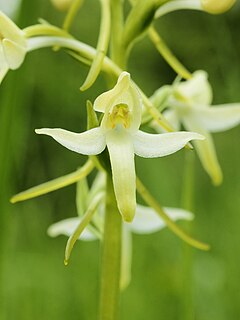
Platanthera praeclara, known as the western prairie fringed orchid and the Great Plains white fringed orchid, is a rare and threatened species of orchid native to North America.

Platanthera leucophaea, commonly known as the prairie white fringed orchid or eastern prairie fringed orchid, is a rare species of orchid native to North America. It is listed as a threatened species in the United States on September 28, 1989. The IUCN does not currently recognize it as being at risk.

Platanthera bifolia, commonly known as the lesser butterfly-orchid, is a species of orchid in the genus Platanthera, having certain relations with the genus Orchis, where it was previously included and also with the genus Habenaria. It is a Palaearctic species occurring from Ireland in the West, across Europe and Asia to Korea and Japan. It is also found in North Africa. The name Platanthera is derived from Greek, meaning "broad anthers", while the species name, bifolia, means "two leaves".

Postlebury Wood is an 87 hectare biological Site of Special Scientific Interest south of Trudoxhill in Somerset, notified in 1987.

Cogley Wood is a 60.7 hectare biological Site of Special Scientific Interest east of Bruton in Somerset, notified in 1987.

Bowerchalke Downs, is a 128.6 hectare biological Site of Special Scientific Interest in Wiltshire, notified in 1971. The downs encompass the entire southern outlook of the village of Bowerchalke in the Salisbury district of Wiltshire, England, and are adjacent to both the Hampshire and Dorset county boundaries. The Bowerchalke Downs are located within the Cranborne Chase and West Wiltshire Downs Area of Outstanding Natural Beauty and are part of the Southern England Chalk Formation.

Pewsey Downs is a 305.3 hectare biological Site of Special Scientific Interest on the southern edge of the Marlborough Downs north of Pewsey in Wiltshire, notified in 1951. It includes the Pewsey Downs National Nature Reserve.

Platanthera ciliaris, commonly known as the yellow fringed orchid, yellow-fringed orchid, or orange-fringed orchid, is a large and showy species of orchid. It grows in "acid soil of hillside seepage bogs" in the longleaf pine landscapes of the Gulf Coast. Like many species in these habitats, including flatwoods, it is dependent upon recurring fire to create open conditions. Further north it is found in bogs, but even here it may be dependent upon fire to create open conditions.

Galley Down Wood is a 16.5 hectare biological Site of Special Scientific Interest in Hampshire, notified in 1988.
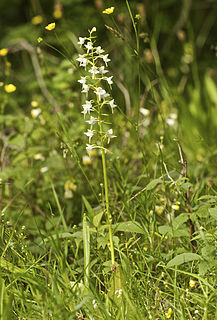
Platanthera chlorantha, commonly known as greater butterfly-orchid, is a species of orchid in the genus Platanthera. It can be found throughout Europe and Morocco. The name Platanthera is derived from Greek, meaning "broad anthers", while the species name, chlorantha, means "green-flowered".

Platanthera yosemitensis, the Yosemite bog orchid, is a species of orchid that is endemic to nine wet montane meadows between the main stem and the South Fork of the Merced River in Yosemite National Park.

Platanthera blephariglottis, commonly known as the white fringed orchid or white-fringed orchis, is a species of orchid of the genus Platanthera. It is considered to be an endangered species in Connecticut and Ohio, a threatened species in Florida, Maryland and Rhode Island, exploitably vulnerable in New York, and susceptible to be threatened in Québec.
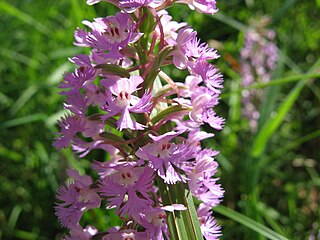
Platanthera psycodes, commonly called lesser purple fringed orchid or small purple-fringed orchid, is a species of orchid, genus Platanthera, occurring from eastern Canada to the east-central and northeastern United States. It is imperiled in Illinois, Tennessee, North Carolina, and Kentucky.
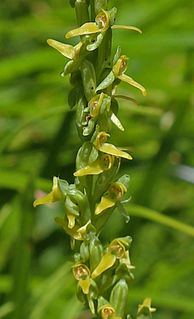
Platanthera tescamnis, the intermountain bog orchid or yellow rein orchid, is a species of orchid described in 2006. The plant is well-known but had been misidentified. It is native to the Great Basin and Colorado Plateau of the western United States, where it grows in warmer, drier habitat than most related orchids.
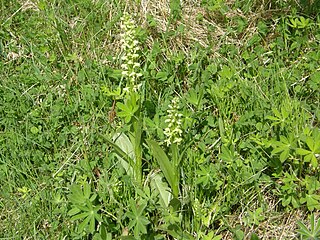
Platanthera hyperborea, the northern green orchid, is small orchid found only in Greenland, Iceland, and Akimiski Island in Canada. Numerous authors cite the species as widespread in other parts of Canada and also in the United States; such populations are more correctly referred to as Platanthera aquilonis.
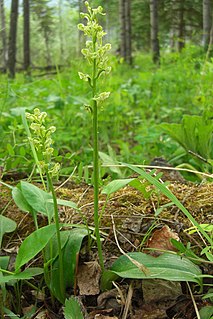
Platanthera obtusata, common name blunt-leaved orchid or small northern bog orchid, is a small species of orchid in the genus Platanthera. It widespread across much of the colder regions of the Northern Hemisphere, though rare in some parts of its range. Two subspecies are recognized:

Platanthera flava, the palegreen orchid, is a species of pale-flowered orchid. It is native to eastern North America, from Texas east to Florida, north to Ontario, Quebec and Nova Scotia.

Platanthera azorica, commonly known as Hochstetter's butterfly orchid, is a species of orchid in the genus Platanthera. It was "rediscovered" in 2013 on a single volcanic ridge on the central Azores island of São Jorge, and "is arguably Europe's rarest bona fide orchid species." While P. azorica was previously considered by some sources to be the same as Platanthera micrantha, the 2013 discovery triggered a thorough analysis of historic and current data and specimens, resulting in three species identified.

Monawilkin is a townland in the West Fermanagh Scarplands in the Civil Parish of Inishmacsaint, Barony of Magheraboy, Northern Ireland. The townland has an area of 85.1947 hectares and has previously been referred to as Meenwilkin (1817) and Munadh Wilkin. Monawilkin is the best example of unimproved calcareous grassland in Northern Ireland. This differs from other Sesleria-dominated grasslands in the UK in that it also includes species such as Euphrasia salisburgensis (eyebright). Monawilikin is also an important orchid site, contains the best inland site for moths and butterflies in Northern Ireland, and is the only Northern Irish site for Cupido minimus, the small blue butterfly. Consequently, this area was designated as a special area of conservation (SAC) and area of special scientific interest (ASSI). The Monawilkin SAC land cover comprises 3% water bodies, 5% bogs, marshes, and fringe water vegetation, 13% heath and scrub, 50% dry grassland, 14% humid grassland, and 15% broad-leaved woodland.

